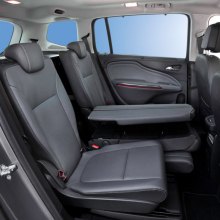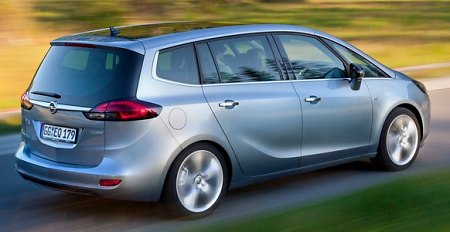In
the 15 years history of compact MPVs, Opel Zafira can be said as a game
changer. It was the first of its kind to feature 7 seats (5 adult and 2
child seats), an amazing achievement for its compact size. Its
innovative "Flexi 7" system also enabled a flat loading bay to be
formed by folding the second and third row, saving the need to remove
the seats like contemporary rivals. These features have become the
class norm today.
Fast forward to the new, third generation Zafira, we can see a further
evolution of the Flexi 7 seats and interior utilities, but in our eyes
the biggest progress is the styling and packaging. Previous Zafiras
were more about practicality than desirability. In contrast, the new
car is very stylish. It looks high quality, too. Opel has applied what
it learned from Insignia and Astra – both are attractive designs – to
shape the Zafira. It has a very aerodynamic shape (with Cd of 0.28) and
many clever features to mask its bulk. A pair of sharp crease lines at
each side, a stylish kick at each C-pillar and fast-angle quarter
windows make it looks dynamic and sophisticated. Up front, arrow-shape
light clusters give it a strong character and a family resemblance to
Opel Ampera (sister car of Chevrolet Volt). This makes the front grille
a little ordinary in comparison. Overall, the new Zafira is easily the
most attractive one in its segment.
The new car features high percentage of glass area to deliver a sense
of
light and airy in the cabin. This is made possible by slim A-pillars,
hence large quarter windows, a panoramic glass roof and an optional
windscreen that extends well into the roof – more so than Citroen C4 !
Once you are on board, you will find a much more pleasing environment.
Not only the dashboard design is stylish by MPV standards, Opel has
finally
learned how to lift the cabin ambience with tasteful color trims,
quality soft-touch plastics and LED ambient lights throughout the cabin.
Utility is also improved. Although it has sacrificed the old car's
roof-mounted central spine storage system for the panoramic glass roof,
it offers as many as 30 storage cubbies and, like Mini Countryman, a
rail system at the central tunnel to clip additional storage boxes,
cupholders or other accessories. Frankly, I don't think many people
would opt for the latter, but at least it proves that these days Opel
can look deep into the details.
Better still, the Flexi-7 seats have become even more flexible. Not
only they can fold flat to place luggage, the middle row has now become
three individual seats rather than a bench seat so that each of the
rear occupants can feel equally comfortable. Moreover, the middle row
can slide back and forth for a range of 280 mm, so you can adjust the
distribution between second row legroom and third row legroom or
luggage space. The rearmost seats are still too cramped for adults,
just like any other 7-seaters of this class.
The most innovative new feature is the "lounge seat" option. As such
equipped, the middle row can be converted to two seats with increased
leg and shoulder room. How to do that? Step one, lower the middle seat
cushion. Step two, fold down the middle seatback. Step three, rotate
the outer portions of the middle seatback upward. Now it is converted
to a narrow, padded armrest. Step four, slide the two outer seats all
the way back. Near the end of the travel they also slide diagonally
towards the center. Consequently, both occupants get limousine level of
shoulder room and legroom plus a comfortable armrest. The only thing
limiting seating comfort is the rather thin and flat shape of the
seats, something compromised with luggage capability.


Talking about luggage space, the new Zafira is even larger than before.
With 5 people on board, the boot measures up to 710 liters, 65 liters
up from the old car. With both second and third row folded, it can even
swallow some 1860 liters of things. Moving home can't be easier.

Mechanically, the MPV
combines the elements of Astra and Insignia, including the former's
torsion-beam and Watts link rear suspension and the latter's MacPherson
struts front suspension. The powertrains are also familiar, including
140hp 1.8-liter DVVT, 140hp 1.4 turbo and a trio of 2.0CDTi turbo
diesel producing either 110hp, 130hp or 165hp. Transmission is either
6-speed manual or 6-speed auto. Due to the car's weight, performance is
hardly sparkling, but the 1.4 turbo petrol and the turbo diesels offer
enough mid-range torque for everyday driving, so most family buyers are
unlikely to complain. Our only criticism is the refinement of the
high-power diesel engine. It sounds rather coarse under pressure, and
its turbo needs more rev to spool up than most modern diesels.

The chassis dynamics is similar. Its ride is refined except on the
poorest roads, especially with optional Flexiride adaptive dampers
selected. Body roll is well controlled. Handling is secured and
predictable. Motorway cruising is remarkably quiet. It is perfectly
acceptable to its target family buyers, but keener drivers will find it
not as capable in corners as the Ford duo – C-Max and S-Max. Its light
steering also lacks feedback from the road to inspire confidence.
That said, most people searching for a people mover are unlikely to
care too much about driving dynamics. To them, the Zafira's versatile
interior, high-quality packaging and stylish looks are already good
enough to seal the deal.